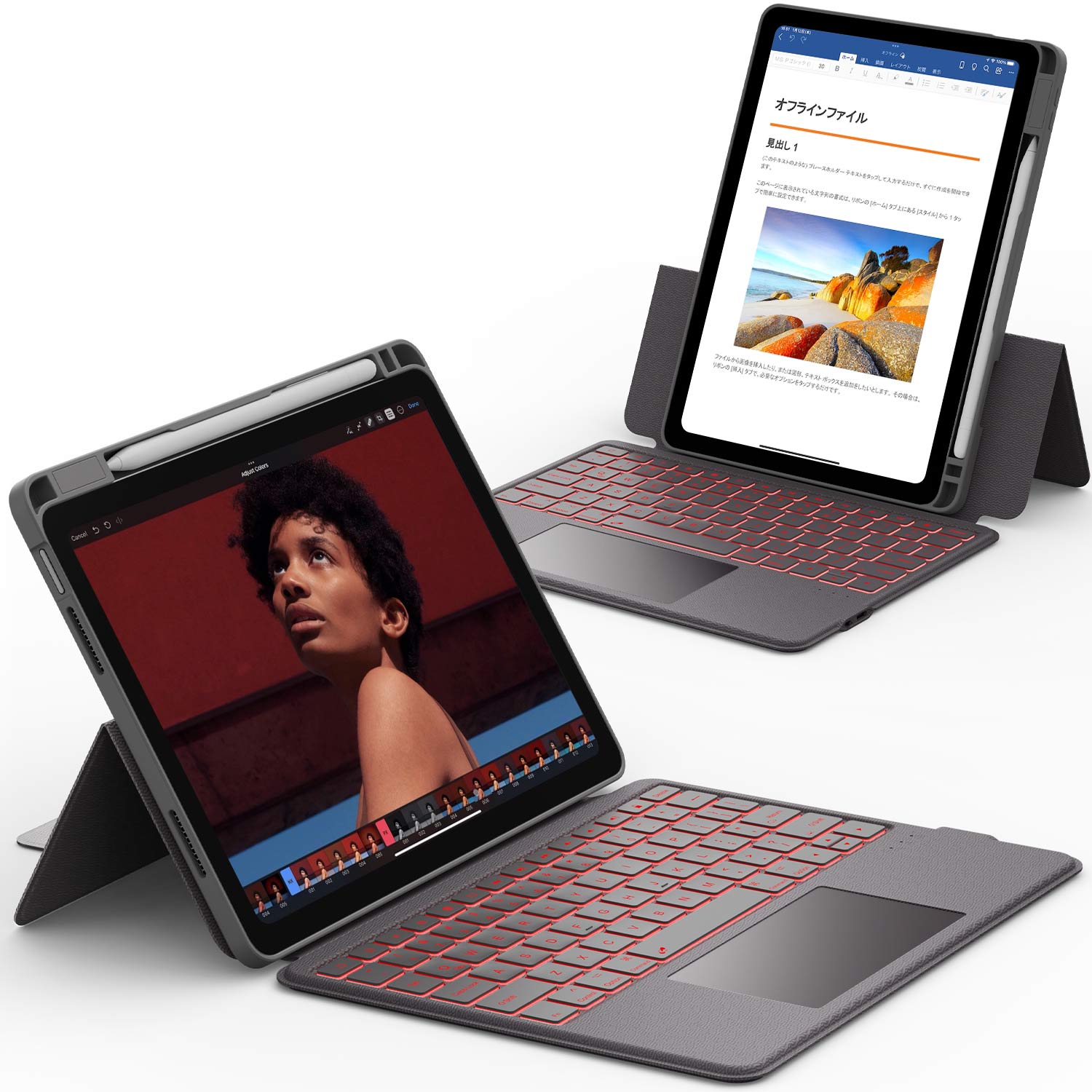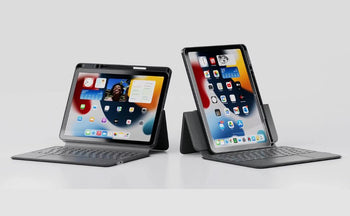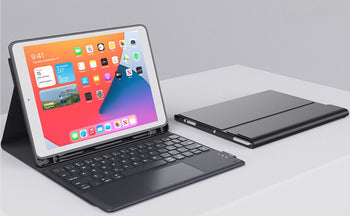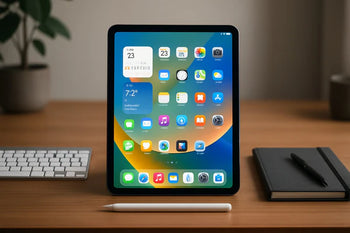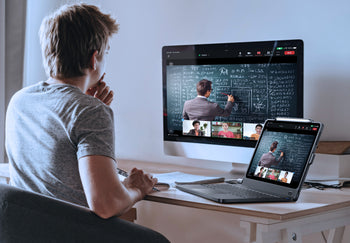Picking between the reMarkable and the iPad really depends on how you like to work and think. Both let you write, draw, and organize your ideas, but they’re built for different kinds of people.
If you want a tool that’s all about writing and focus, the reMarkable is your best bet. If you need a device for apps, browsing, and creativity, the iPad wins.
You’ll notice the difference as soon as you pick them up. The reMarkable feels like paper and helps you stay in the zone since there are no notifications or extra apps.
The iPad, though, gives you a bright display, fast performance, and tons of tools. It’s powerful and flexible.
Discover premium protection with our iPad Pro M4 case collection.
Core Differences Between Remarkable and iPad
The iPad and reMarkable tablets serve pretty different needs. One is all about versatility and performance, and the other is about simplicity and focus.
Their hardware, design, and user experience really show these differences.
Device Purpose and Philosophy
The iPad is a do-it-all tablet. You can browse the web, stream, game, read, or get creative.
It supports thousands of apps through the App Store, so it’s super flexible for both fun and work.
The reMarkable 2 and reMarkable Paper Pro go the opposite way. These e‑ink devices are almost only for writing, sketching, and reading.
They skip distractions like social media, notifications, or games.
The iPad encourages multitasking and creativity. The reMarkable helps you slow down and focus on handwriting and thoughtful work.
|
Feature |
iPad |
reMarkable 2 / Paper Pro |
|
Main Use |
All‑purpose tablet |
Digital paper for writing |
|
Apps |
Wide selection |
Limited, note‑focused |
|
Distractions |
Many |
Very few |
Design and Portability
The reMarkable 2 is super thin and light—about 4.7 mm thick and just over 400 grams. It’s close to holding a real notebook.
The design is minimalist. No cameras, no speakers, not even a backlight. It’s all about keeping things simple.
The iPad has more hardware. You get cameras, speakers, and a bright color touchscreen.
It’s heavier, but still pretty portable, especially if you pick the iPad Mini.
If you want a paper-like feel and easy carrying, the reMarkable stands out. If you want one device for everything, the iPad’s extras make it more capable.
User Interface and Experience
The iPad runs iPadOS. You get multitasking, widgets, and app management.
You can connect an Apple Pencil or Magic Keyboard. The screen is smooth glass, which feels different than paper.
The reMarkable tablet has a custom interface that’s minimal and fast. You use a stylus and simple touch gestures.
The e‑ink display feels like paper. You get some texture when you write or sketch.
You can sync notes to the cloud, but there’s no app store or notifications. The interface keeps your attention on what you’re making—not what’s popping up.
Check out Best iPad Pro Apps to Power Up Your Device to maximize your tablet’s potential.
Note-Taking Experience

You can use both the reMarkable and iPad for digital note-taking, but they feel really different. The reMarkable is all about handwriting and simplicity.
The iPad throws in more tools, apps, and multitasking. How you like to write, sketch, and stay focused will probably decide which one you want.
Handwriting and Sketching Capabilities
The reMarkable Paper Pro and iPad Air both let you use a stylus with tilt and pressure sensitivity. The reMarkable’s Marker Plus stylus even has an eraser on the back.
It feels natural and accurate when you write or sketch. The Apple Pencil Pro also has tilt and pressure, but adds digital gestures like double-tap shortcuts or squeeze features.
You can switch tools or undo without touching the screen. That’s handy for creative work or quick edits.
If you draw diagrams or annotate PDFs, the iPad gives you more flexibility with apps like GoodNotes, Notability, or Procreate. The reMarkable limits you to its built-in tools, but they’re simple and reliable for handwriting and sketching.
|
Feature |
reMarkable Paper Pro |
iPad Air + Apple Pencil Pro |
|
Latency |
~12ms |
Very low (unspecified) |
|
Eraser |
Built-in |
On-screen or gesture-based |
|
Pressure & Tilt |
Yes |
Yes |
|
Gesture Controls |
No |
Yes |
Paper-Like Writing Feel
The reMarkable’s color e-ink display has a textured surface that feels close to real paper. When you write, there’s some friction between the stylus and screen, which helps your handwriting look more natural.
You can rest your hand on the screen without leaving marks. The iPad’s glass display feels smoother and faster, but doesn’t have that paper-like grip.
You can add a matte screen protector to the iPad, but it’s not quite the same. If you love the physical act of writing, the reMarkable just feels better.
If you want bright colors and fluid scrolling, the iPad’s glossy display is the way to go.
Distraction-Free Note-Taking
The reMarkable’s big strength is its distraction-free note-taking setup. No social media, games, or notifications here.
You just open your notebook, write, and stay in your thoughts. Your notes sync quietly to the cloud, but you never get pop-ups or alerts.
It feels calm and intentional. The iPad, on the other hand, always gives you access to apps, messages, and the web.
You can silence notifications or use Focus Mode, but the temptation to switch tasks is always there. The iPad is powerful, but you need more discipline to stay on task.
Focused Note-Taking vs. Multitasking
With the reMarkable, you focus on one thing at a time—writing, sketching, or reading. It’s great for deep work or journaling.
No need to juggle windows or apps. The iPad lets you multitask, split the screen, open reference material, or record audio while you take notes.
This flexibility helps if you need to research or work across apps. If you want a digital notebook that keeps you centered on handwriting, the reMarkable is the one.
If you want a device that combines note-taking with productivity tools, the iPad fits better.
Find hands-free comfort in our iPad cases with stand collection.
Display Technology and Visual Experience
You’ll spot a clear difference in how each tablet shows text and images. The reMarkable 2 has a paper-like, grayscale display for writing.
The iPad uses bright color screens made for media, design, and multitasking. This really changes how you see and interact with your notes and apps.
E-Ink Display vs Retina and OLED Screens
The reMarkable 2 uses an E-Ink display that looks and feels like paper. It only shows shades of gray and refreshes slowly, but it’s perfect for reading and handwriting.
No glare or reflections, even in sunlight. The iPad lineup uses Retina, Liquid Retina, or OLED displays, depending on which model you get.
These screens are sharp, colorful, and bright. You can watch videos, draw in color, and edit photos with detail.
E-Ink screens use very little power, so the reMarkable 2 lasts much longer. iPad screens use more energy, but they give you a vivid, fast experience that’s great for both work and play.
|
Feature |
reMarkable 2 (E-Ink) |
iPad (Retina / OLED) |
|
Color |
Monochrome |
Full color |
|
Refresh rate |
Slow |
Fast |
|
Power use |
Very low |
Moderate to high |
|
Best for |
Writing, reading |
Media, multitasking |
Screen Size and Resolution
The reMarkable 2 has a 10.3-inch display with a resolution of 1872 × 1404. Text looks crisp for note-taking and sketching.
The matte surface adds light friction, so the stylus feels like writing on paper. The iPad comes in a bunch of sizes, from 10.9-inch (Liquid Retina) to 12.9-inch (Mini LED Liquid Retina XDR).
These screens go up to 2732 × 2048 resolution, so you get fine detail and smooth gradients. If you want a big canvas for drawing or multitasking, the iPad’s higher resolution and color depth really stand out.
If you like a focused tool for writing, the reMarkable’s size and texture might feel more natural.
Eye Comfort and Outdoor Use
The E-Ink screen on the reMarkable 2 is easy on your eyes. It doesn’t have a backlight, so you don’t get the blue light you see with LCD or OLED screens.
This makes it pretty comfortable for long reading or writing sessions. You can use it outside without glare, even in bright sunlight.
But if you’re in a dim room, you’ll probably need an extra light since the screen is hard to see. That’s the trade-off for no backlight.
iPad’s Retina and OLED screens are bright and backlit, with anti-reflective coatings to cut glare. Some people get eye strain after long use in low light, though.
You can adjust the brightness or turn on True Tone and Night Shift to make it easier on your eyes.
Explore Best Tablet for the Money: Value That Lasts for a smart buying decision.
Productivity and App Ecosystem
CHESONA Step Series Keyboard Case for iPad Pro 11" 4th/3rd/2nd/1st Gen/Air 10.9"
The way each tablet helps you work is pretty different. The iPad is all about flexibility and multitasking, while the reMarkable tries to keep things simple and distraction-free.
Your decision really depends on whether you want a full app store or just a focused writing and reading tool.
App Availability and Ecosystem
The iPad runs iPadOS and connects you to the App Store with millions of apps. You can grab tools for work, school, art, or just goofing off.
Apps like Microsoft Office, Google Drive, and Slack make it pretty easy to handle projects and work with others. You can connect your iPad to iCloud for automatic syncing across your Apple devices.
Moving between your iPhone, Mac, and iPad feels seamless. Meanwhile, the reMarkable takes a different path.
It’s a closed system built for minimal distraction. You can sync notes through the reMarkable Cloud, but you won’t find third-party apps or streaming here.
This focused setup lets you write and think without annoying notifications or social media popping up.
|
Feature |
iPad |
reMarkable |
|
App Store |
Yes |
No |
|
Cloud Sync |
iCloud, Google Drive, Dropbox |
reMarkable Cloud |
|
Third-Party Apps |
Wide range |
None |
Note-Taking Apps Comparison
If you take notes a lot, the iPad gives you more options. You can use GoodNotes, Notability, or OneNote to write, draw, and organize.
These apps support handwriting, audio recording, and cloud sharing. Pairing the iPad with the Apple Pencil makes writing feel smooth and quick.
The reMarkable just sticks with its built-in note app. It feels almost like writing on paper, thanks to low latency and a matte screen.
You can make folders, convert handwriting to text, and sync notes online. The iPad gives you more tools and customization, but the reMarkable’s simple setup helps you focus on writing, not fiddling with apps.
It’s great if you want a digital notebook without all the extra distractions.
Multitasking and Workflow Tools
The iPad supports multitasking, like Split View, Slide Over, and Stage Manager. You can open more than one app at once—maybe read in Safari while jotting notes in OneNote.
Add a Magic Keyboard or trackpad, and your iPad can almost replace a small laptop. You can also connect to cloud services like Google Drive or iCloud Drive to get your files anywhere.
These features make the iPad a solid pick for productivity on the go. The reMarkable doesn’t do multitasking or external apps.
You can only see one document at a time. This limits more complex workflows, but honestly, it helps you stay focused on just one thing at a time.
If you like deep, uninterrupted work, that simplicity might be a real advantage.
Choose the heavy duty iPad case for rugged reliability and ultimate protection.
Battery Life and Charging
You’ll see a big difference in how long each device lasts before you need to charge. The reMarkable 2 is all about efficiency, while the iPad packs in more power for heavy features.
Battery Performance Comparison
The reMarkable 2 uses an E‑Ink display that barely sips power. You can get up to two weeks on one charge, depending on how much you write or sync.
Some people even go nearly a month between charges with light use. On the other hand, an iPad (like the iPad Air or iPad Pro) gives you about 10 hours of active use.
This shorter battery life comes from its bright, high-res screen and support for demanding apps like streaming or gaming.
|
Device |
Estimated Battery Life |
Display Type |
Typical Use Pattern |
|
reMarkable 2 |
Up to 14 days or more |
E‑Ink |
Note-taking, reading |
|
iPad (various models) |
Around 10 hours |
LCD or Mini LED |
Mixed productivity, media |
If you want a device that stays ready for days, the reMarkable 2 fits that need. If you want full app support and power, you’ll charge your iPad more often.
Charging Convenience
Both tablets use USB‑C ports. The reMarkable 2 charges slowly and takes a few hours to fill up, but you won’t need to plug it in all the time.
The iPad charges faster, especially with higher-watt chargers. You’ll probably recharge it daily or every few days, depending on how you use it.
If you travel a lot, the reMarkable 2’s long battery life means fewer cables to pack. If your iPad is your main work or play device, it’s smart to keep a charger handy.
Bottomline
CHESONA ArmorDock Series Keyboard Case for iPad Pro 12.9" 6/5/4/3th
Comparing the reMarkable tablet vs iPad shows how each excels in different ways. The reMarkable focuses on distraction-free writing, while the iPad offers versatility for creativity, productivity, and entertainment.
If you choose the iPad, protect your investment with CHESONA’s durable and stylish iPad cases.
Designed for comfort, drop protection, and smart features, CHESONA cases elevate your experience—whether you’re taking notes, drawing, or working on the go. Explore CHESONA’s iPad and tablet cases today to keep your device safe and functional in every situation.
Read our article, Best Writing Tablet: Choose Yours Today, to see which device fits your needs best.
Frequently Asked Questions
What are the main differences in writing experience between a ReMarkable tablet and an iPad?
The ReMarkable feels a lot like writing on paper. Its textured e-ink screen gives you a pen-on-paper vibe with hardly any glare.
The iPad’s glossy LCD or OLED screen feels more like writing on glass. You get color, brightness, and tons of app options, but it just doesn’t have that same paper feel.
Can you compare the battery life of ReMarkable tablets and iPads?
The ReMarkable lasts way longer on a single charge—often up to two weeks if you use it normally. Its e-ink display barely uses power.
An iPad usually runs about 10 hours before you need to plug it in. Streaming, gaming, or multitasking will drain it even faster.
How do the note-taking capabilities of ReMarkable and iPad differ?
The ReMarkable lets you take distraction-free notes and focuses on just writing and reading. It syncs your notes to the cloud and can turn handwriting into text.
The iPad supports apps like Apple Notes, Notability, and GoodNotes. You get more ways to organize, share, and even add multimedia to your notes.
What are the price points of ReMarkable tablets and iPads?
The ReMarkable Paper Pro costs around $679 if you get the Marker Plus. Extras like cases or keyboards add to the price.
An iPad Air starts near $599. But if you want the Apple Pencil Pro and a keyboard, that bumps up the total. Sometimes you’ll find sales, so the two setups can end up costing about the same.
How does the stylus performance for drawing and writing compare between the two devices?
The ReMarkable Marker Plus has super low latency, tilt and pressure sensitivity, and an eraser on the back. It charges magnetically and feels pretty balanced.
The Apple Pencil Pro also supports tilt and pressure, plus adds squeeze gestures and deep system integration. It’s more advanced for creative apps, but it glides more on the screen than the Marker Plus.
What are the storage options available for ReMarkable and iPad?
ReMarkable tablets come with fixed internal storage. You usually get 8GB or 16GB, which holds thousands of notes and PDFs.
If you need to back up files, you can use the cloud. It's not a ton of space, but for just notes, it's honestly plenty.
iPads give you way more choices for storage. You can pick from 64GB all the way up to 1TB.
That means you can stash loads of apps, photos, or videos. If you ever run out, iCloud adds even more room.
